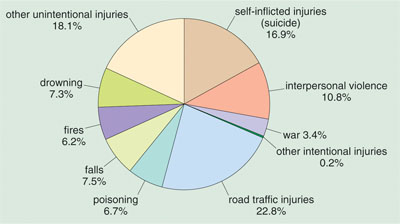7.1 Acute injury and violence
Acute injury refers to any physical damage to the body that occurs suddenly as a result of force. There are many ways in which a person can be injured, either unintentionally (for example, in an accidental fall or being hit by a vehicle), or intentionally through violence, war or attempted suicide. Figure 7.1 (on the next page) shows the distribution of deaths as a result of different types of injury worldwide.

What are the top four causes of injury-related deaths shown in Figure 7.1?
They are: road traffic injuries (22.8%), other unintentional injuries (18.1%, i.e. not due to drowning, fires, falls or poisoning), suicide (16.9%), and interpersonal violence (10.8%).
Violence includes rape and is the intentional and unlawful use of force between two individuals, or a group of people, leading to physical or mental harm. It is a major public health problem worldwide – each year more than two million people die as a result of injuries caused by violence. Many millions survive their injuries, but remain permanently disabled. Many other health problems result from violent assaults, including mental disorders (see Part 2 of this Module), sexually transmitted infections (STIs), unwanted pregnancies and behavioural problems.
Learning Outcomes for Study Session 7
